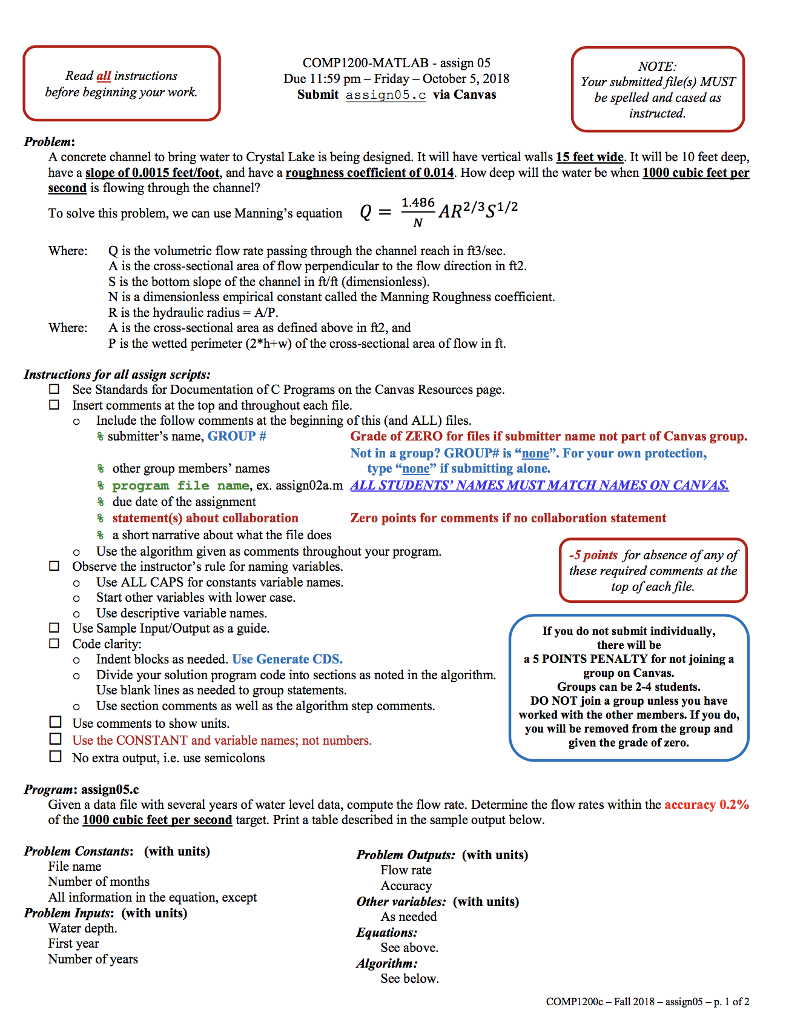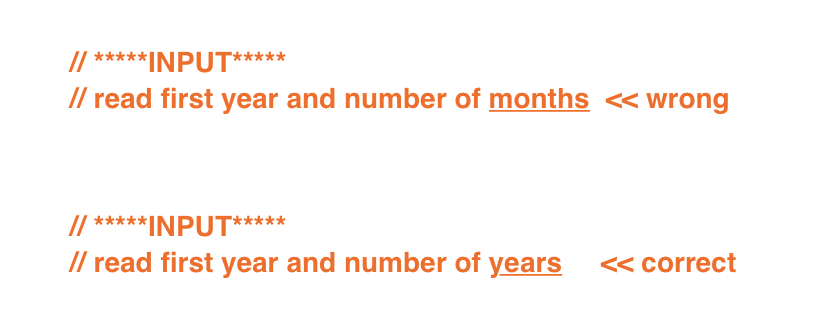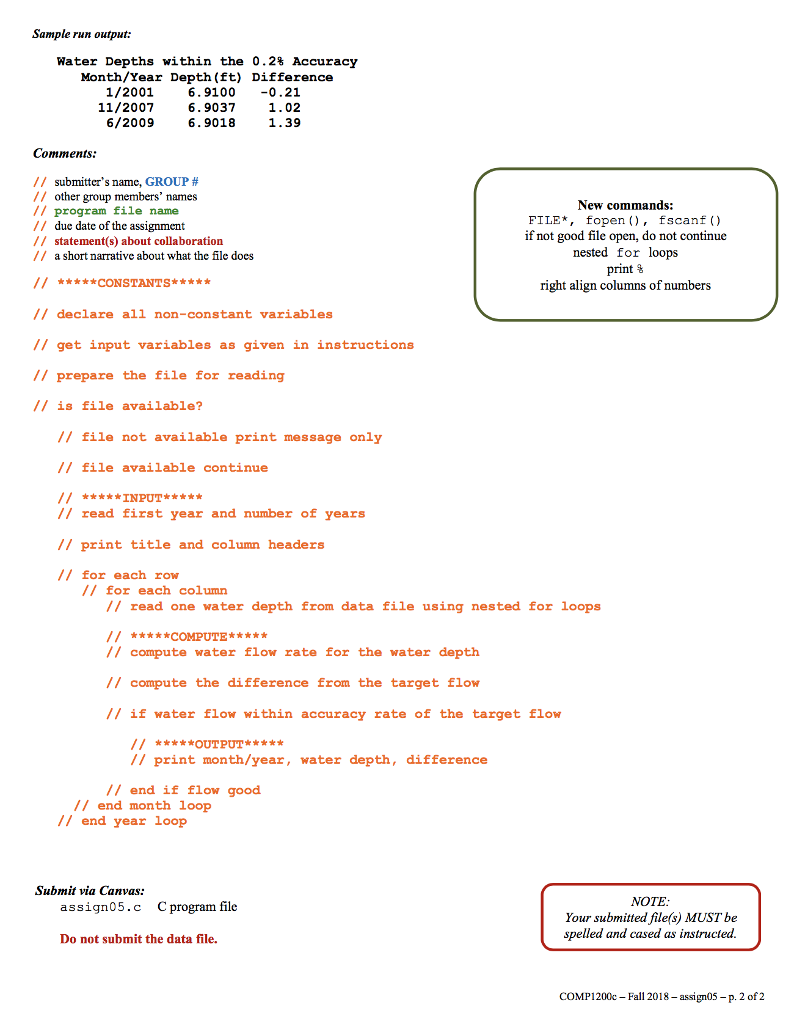




COMP1200-MATLAB - assign 05 Duc 11:59 pm - Friday - October 5,2018 Submit assign05.c via Canvas NOTE Your submitted filess) MUST be spelled and cased as instructed. Read all instructions before beginning your work. Problem: A concrete channel to bring water to Crystal Lake is being designed. It will have vertical walls 15 feet wide. It will be 10 feet deep, have a slope of 0.0015 feet/foot, and have a rou second is flowing through the channel? How deep will the water be when 1000 cubic feet per To solve this problem, we can use Manning's equation Q- 1.436AR2/3s1/2 Where: Q is the volumetric flow rate passing through the channel reach in ft3/sec A is the cross-sectional area of flow perpendicular to the flow direction in ft2. S is the bottom slope of the channel in ft'ft (dimensionless) N is a dimensionless empirical constant called the Manning Roughness coefficient. R is the hydraulic radius-A/P Where:A is the cross-sectional area as defined above in ft2, and P is the wetted perimeter (2*h+w) of the cross-sectional area of flow in ft. Instructions for all assign scripts: See Standards for Documentation of C Programs on the Canvas Resources page. Insert comments at the top and throughout each file o Include the follow comments at the beginning ofthis (and ALL) files. % submitter's name, GROUP # Grade of ZERO for files if submitter name not part of Canvas group. Not in a group? GROUP# is "none". For your own protection, % other group members' names % program file n % due date of the assignment % statement(s) about collaboration % a short narrative about what the file does type "none" if submitting alone. ame, ex. assign02a.m Zero points for comments if no collaboration statement o Use the algorithm given as comments throughout your program. Observe the instructor's rule for o Use ALL CAPS for constants variable names. o Start other variables with lower case o Use descriptive variable names. Use Sample Input/Output as a guide. 5 points for absence of any of these required comments at the top of each file. variables. If you do not submit individually, there will be a 5 POINTS PENALTY for not joining a group on Canvas. Groups can be 2-4 students. DO NOT join a group unless you have worked with the other members. If you do, you will be removed from the group and given the grade of zero. Code clarity: Indent blocks as needed. Use Generate CDS. Divide your solution program code into sections as noted in the algorithm. Use blank lines as needed to group statements. o o o Use section comments as well as the algorithm step comments. Use comments to show units. Use the CONSTANT and variable names; not numbers. No extra output, i.e. use semicolons gram: assign05.c Given a data file with several years of water level data, compute the flow rate. Determine the flow rates within the accuracy 0.2% of the 1000 cubic feet per second target. Print a table described in the sample output below Problem Constants: (with units) Problem Outputs: (with units) File name Number of months All information in the equation, except Flow rate Other variables: (with units) Equations: Algorithm Accuracy As needed See above. See below Problem Inputs: (with units) Water depth. First year Number of years COMPI 200c-Fall 2018-assign05_p. 1 of2 COMP1200-MATLAB - assign 05 Duc 11:59 pm - Friday - October 5,2018 Submit assign05.c via Canvas NOTE Your submitted filess) MUST be spelled and cased as instructed. Read all instructions before beginning your work. Problem: A concrete channel to bring water to Crystal Lake is being designed. It will have vertical walls 15 feet wide. It will be 10 feet deep, have a slope of 0.0015 feet/foot, and have a rou second is flowing through the channel? How deep will the water be when 1000 cubic feet per To solve this problem, we can use Manning's equation Q- 1.436AR2/3s1/2 Where: Q is the volumetric flow rate passing through the channel reach in ft3/sec A is the cross-sectional area of flow perpendicular to the flow direction in ft2. S is the bottom slope of the channel in ft'ft (dimensionless) N is a dimensionless empirical constant called the Manning Roughness coefficient. R is the hydraulic radius-A/P Where:A is the cross-sectional area as defined above in ft2, and P is the wetted perimeter (2*h+w) of the cross-sectional area of flow in ft. Instructions for all assign scripts: See Standards for Documentation of C Programs on the Canvas Resources page. Insert comments at the top and throughout each file o Include the follow comments at the beginning ofthis (and ALL) files. % submitter's name, GROUP # Grade of ZERO for files if submitter name not part of Canvas group. Not in a group? GROUP# is "none". For your own protection, % other group members' names % program file n % due date of the assignment % statement(s) about collaboration % a short narrative about what the file does type "none" if submitting alone. ame, ex. assign02a.m Zero points for comments if no collaboration statement o Use the algorithm given as comments throughout your program. Observe the instructor's rule for o Use ALL CAPS for constants variable names. o Start other variables with lower case o Use descriptive variable names. Use Sample Input/Output as a guide. 5 points for absence of any of these required comments at the top of each file. variables. If you do not submit individually, there will be a 5 POINTS PENALTY for not joining a group on Canvas. Groups can be 2-4 students. DO NOT join a group unless you have worked with the other members. If you do, you will be removed from the group and given the grade of zero. Code clarity: Indent blocks as needed. Use Generate CDS. Divide your solution program code into sections as noted in the algorithm. Use blank lines as needed to group statements. o o o Use section comments as well as the algorithm step comments. Use comments to show units. Use the CONSTANT and variable names; not numbers. No extra output, i.e. use semicolons gram: assign05.c Given a data file with several years of water level data, compute the flow rate. Determine the flow rates within the accuracy 0.2% of the 1000 cubic feet per second target. Print a table described in the sample output below Problem Constants: (with units) Problem Outputs: (with units) File name Number of months All information in the equation, except Flow rate Other variables: (with units) Equations: Algorithm Accuracy As needed See above. See below Problem Inputs: (with units) Water depth. First year Number of years COMPI 200c-Fall 2018-assign05_p. 1 of2











